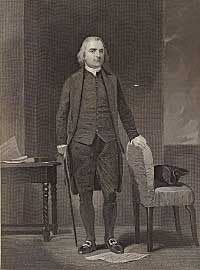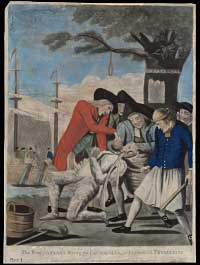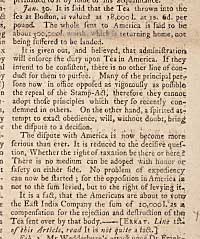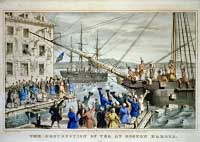Page content
Online Extras
Extra Images

Colonial Williamsburg
A band of patriots dressed as Indians mixed chests of British tea with Boston Harbor water to serve a brew of rebellion.

Colonial Williamsburg
Paul Revere’s engraving of the Boston Massacre aimed to stir up patriot outrage.

Colonial Williamsburg
Engraving of Bostonian Samuel Adams, after the 1862 portrait by Alonzo Chappell

Library of Congress
The “Tea-Tax Tempest” and the Revolution, seen in the long view. Father Time flashes a magic lantern picture of an exploding teapot to America on the left and Britannia on the right, with patriots advancing, right, and redcoats, left. The 1778 engraving is attributed to a German artist, Carl Guttenberg.
Trouble Brewing
Rally, Mohawks!
by Ivor Noël Hume
Editor’s note: We are taught that history repeats itself and so assume that the Tea Party movement of our time is the direct descendent of the Boston party of 1773. In name, it is, and there are similarities in that the press has played a major role in both and change is a theme of each. At its outset, the colonial Tea Party was regionally focused and attended by Massachusetts and Rhode Island radicals. But Samuel Adams and Paul Revere bore no resemblance to today’s populist protesters.
Tea Time in Boston
Hark–or does the Muse’s ear
Form the sounds she longs to hear–
Hark! From yonder western main
O'er the white wave echoing far,
Vows of duty swell the strain,
And drown the notes of war.–William Whitehead, poet laureate
“Ode on the King’s Birthday,” June 4, 1774
The acrid odors of war and rebellion were already wafting from yonder western main and more specifically from the direction of Boston, Massachusetts. In London, Parliament heard that colonial opposition to its laws originated in the colony that “had been always instigated to such conduct, by the irregular and seditious proceedings of the town of Boston.”
Differing from Virginia and Williamsburg, Boston and Providence, Rhode Island, were centers for general international trade. Their movers and shakers were merchants for whom any limits on their commerce were seen as an invasion of their rights as free men. In Virginia, the leaders were planters, many of them with ties to well-born English families, their incomes derived from tobacco and less from the retail sale of paper, paint, glass, lead, or tea. In 1767, the English chancellor of the exchequer, Charles Townshend, imposed duties on those commodities and sent ships and customs officers backed by soldiers to ensure that they were enforced. Neither their presence nor their methods were well received in New England.
Boston radical Samuel Adams was one of three who composed a circular letter, distributed under the seal of the Massachusetts General Court, arguing that a man’s honestly acquired possessions were his and could not be taken from him without his consent–meaning that they could not be taxed by any authority other than that of his colonial assembly. In short, the slogan became “No taxation without representation.”
Once a slogan or an idea takes wing, otherwise self-centered and law-abiding people turn private whispers into public shouting. And so it was in Boston after the Townshend Acts were imposed. When the philosophically reasonable but rabble-rousing letter reached London, the British Government ordered Massachusetts Governor Thomas Hutchinson to demand its withdrawal. The colony’s General Court, however, defied the governor and voted 92–17 to let it stand, thus ensuring that the numbers 92 and 17 would be added to the circulating slogans.
Sympathetic resolutions were passed in the Virginia Assembly, and in normally loyal and low-key Philadelphia, lawyer John Dickinson published his own letter declaring that though taxes regulating trade were constitutional, those imposed to enhance British revenues were not. The Townshend Acts were not trade regulating but were raised to cover Britain’s cost of governing the colonies–which included paying handsome salaries to its colonial officials. It could be argued, therefore, that the colonists were being required to dip into their pockets to subsidize officers not of their choosing. This was the kind of response that employees voice when they learn the size of their bosses’ bonuses and expense accounts.
The first so-called shots heard around the world were fired not at Lexington in 1775 but in Boston on March 5, 1770, when British troops of the 29th Regiment were goaded by a gang of rock and snowball hurling thugs into firing shots that killed five of the activists. Paul Revere and his fellow radicals saw it differently. He published a broadsheet illustrating the event and titled it “The Bloody Massacre perpetrated in King Street Boston.” Perhaps emphasizing the innocence of the rioters, Revere showed a dog standing in the foreground of the blood-spattered crowd. This was wonderful propaganda, enhanced by doggerel that declared that the soldiers,
With murd’rous Rancour stretch their bloody hands, Like fierce Barbarians grinning o'er their Prey.
The Boston news media were having a field day, and it mattered little that the five dead were reported as seven.
In the following months, some colonists saw the English redcoats in that light, and hooligans having fun in the name of patriotism subjected them to individual nocturnal attacks. These were Boston’s amateur foot soldiers contributing to the cause of freedom. Although such intimidation appalled many of Boston’s older citizens, men like the thirty-five-year-old Paul Revere were wooing a younger generation of hotheads that included journeymen and apprentices and at least one black American, Crispus Attucks, whose life ended on King Street that day in March 1770.
The Boston Massacre was dismissed in England as mob violence put down in the way it would in London, where civil disobedience was common and similarly treated.
Although Samuel Adams and his small circle of radicals did what they could to keep the fire of rebellion alive, the next two years saw Anglo-American relations greatly improved. Lord North had become prime minister of a conciliatory government, and the king withdrew Townshend’s tariff on all the essential imports save for the tea, which was seen as a luxury. His ministers had not considered that the hostesses of tea parties in Boston and elsewhere would thereby be encouraged to interest themselves in the politics of their menfolk. Nevertheless, the removal of the commodity tariffs were a relief to masons, carpenters, printers, and the like, and so restored the status quo–a condition not at all to the liking of Adams and his similarly minded associates.
The night of June 9, 1772, provided exactly what Adams needed. While chasing a smuggler into Narragansett Bay, the British revenue schooner Gaspee ran aground. The ship had been on station since January, its presence a constant irritant to the contraband-prone merchants of Providence, Rhode Island. Their annoyance had been stoked by radical Solomon Southwick, editor of the Newport Mercury, whose February 24 issue called the Gaspee a piratical schooner belonging to George III, who should have known better than “to keep men of war employed in robbing some of the poorest subjects.”
Who it was who saw the Gaspee run aground and rallied local patriots to attack it has never been proven. But attack it they did, burning the ship to its waterline. When the news reached England, Parliament ordered a commission to be created in Massachusetts to identify the attackers and ship them to England to stand trial. That intent was imparted to Governor Hutchinson in a letter from Secretary of State Lord Dartmouth. But as so often happens, the confidential directive was leaked to the press and generated outraged editorials in the Newport Mercury and Providence Gazette to further stoke the republican fire.
On December 26, 1772, the Gazette reported that troops were being sent from Massachusetts and New York to police Rhode Island, an intrusion, it said, likely to repeat the outrage that “made the 5th of March so memorable in Boston.”
The so-called Boston Massacre had thus been converted from a riot to a republican cause célèbre. It is true that troops were sent to Rhode Island, but they entered Newport unopposed; yet, when that news reached Purdie and Dixon’s Virginia Gazette in Williamsburg, readers were told that “eighteen of the Rhode Island People were wounded and about six of them killed,” and “some of the Regulars were slain.”
The power of a politically motivated press was driving King George’s northern colonies to the cliff’s edge.
On the other side of the world, mismanagement by Britain’s contractors in India was occupying the attention of Parliament. The East India Company, which for nearly two centuries had governed itself, was subjected to seven new rules of operation that transferred most of its authority to the crown.
To secure the acquiescence of the company’s shareholders, however, its existing stock of 17,000,000 pounds of tea could be exported duty free to any market without the normal requirement that it first be landed and taxed in England. Consequently, the price could be lowered, and at no cost to the shippers the chests of tea could be sent directly to company consignees in America, where the duty was still levied at three pence a pound.
Vocal patriots urged that the ships should be turned away and appealed to Governor Hutchinson to so order. When he declined, and company agents were still expecting to legally receive the tea, Bostonians did what they considered necessary to ensure that they did not. On the afternoon of December 16, 1773, at a meeting in the home of Benjamin Edes, part owner of the Boston Gazette, Adams, Josiah Quincy Jr., and others laid plans to prevent the tea from being brought ashore.
At the Gazette office, the conspirators disguised themselves as Indians and gathered with 200 likeminded friends and neighbors at the South Church. There, Adams gave the order to repair to the Green Dragon Inn, where other sympathizers joined them. Together, and in silence, they made their way to Griffin’s wharf, where the East India Company ships were riding, ostensibly protected by British men-of-war. Unopposed, indeed unnoticed, the militants boarded the anchored tea-laden ships, politely called on their captains to surrender the keys to their holds, hauled the crates onto their decks, broke them open with their pseudo-Indian hatchets, and tossed 342 chests of tea into the harbor. The deed done, no other cargo was touched, and the “Mohawks” peacefully went home.
The men-of-war in the harbor had done nothing to prevent the outrage, probably because they did not know what was going on until it was too late. The following morning, ignoring the warships, boats manned by concerned citizens put out into the harbor and drowned any chests that were still floating. A week later John Hancock said that “No one circumstance could possibly have taken place more effectively to unite the Colonies than this manouvre of the Tea.”
In London, on January 29, 1774, Benjamin Franklin appeared before the Privy Council to defend a petition from the Province of Massachusetts demanding action against Governor Hutchinson for his refusal to comply with the colonists’ instructions. The petition was rejected, and Dr. Franklin was told that it was “groundless, vexatious, scandalous, and calculated only for the seditious purposes of keeping up a spirit of clamour and discontent in the province.”
The Boston Tea Party entered world history as a solitary event. Nevertheless, the arrival of East India Company ships in such other ports as Philadelphia and Charleston prompted comparable attention, being turned away, their tea destroyed, or landed and impounded. But it had been that gathering of Mohawks at the Green Dragon that found its way into patriotic verse:
Rally, Mohawks! bring out your axes,
And tell King George we'll pay no taxes
On his foreign tea;
His threats are vain, and vain to think
To force our girls and wives to drink
His vile Bohea!
Then, rally, boys, and hasten on
To meet our chiefs at the Green Dragon.
Williamsburg’s Ivor Noël Hume contributed to the summer 2011 journal a story about Jamestown laws. The University of Virginia Press last autumn published his autobiography, A Passion for the Past: The Odyssey of a Transatlantic Archaeologist. ISBN: 978-0-8139-2977-4, $29.95 hardcover.
Suggestions for further reading:
- Anonymous, The Annual Register, or a View of the History, Politics, and Literature for the Year 1774 (London, 1775).
- John R. Alden, A History of the American Revolution (New York, 1969).
- William Bell Clark, ed., Naval Documents of the American Revolution (Washington, DC, 1964).
- Henry Steele Commager and Richard B. Morris, eds., The Spirit of Seventy-Six (New York, 1975).
- Charles Mayo, A Compendious View of Universal History from the Year 1753 to the Treaty of Amiens in 1802 (London, 1804).
- Arthur M. Schlesinger, Prelude to Independence: The Newspaper War on Britain, 1764–1776 (New York, 1958).




